|
|
|
Sort Order |
|
|
|
Items / Page
|
|
|
|
|
|
|
| Srl | Item |
| 1 |
ID:
174644
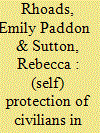

|
|
|
|
|
| Summary/Abstract |
Over the past decade, a body of scholarship on civilian self-protection (CSP) has emerged, advancing understandings of civilian agency in war. In this article, we argue that CSP has been conceptualized in a narrow manner, reflecting the nascent status of the field. Scholars have focused on responses to threats directly related to the dynamics of conflict, physical in nature, and caused by the presence of armed groups. Using the case study of the Protection of Civilians (PoC) sites in South Sudan and drawing on over 150 interviews, we identify one type of protective response neglected in the literature: community and popular justice. Although the PoC sites provide a measure of protection, residents face a range of daily threats that are indirectly related to the conflict, such as crime. In this context, community justice emerged as a natural response, an overlooked yet vital form of CSP that addresses immediate protection needs and fulfills a social ordering function. By conceiving of justice in this way, this article aims to deepen understanding of civilian agency and start a conversation with scholars and practitioners about the boundaries of (self) protection.
|
|
|
|
|
|
|
|
|
|
|
|
|
|
|
|
| 2 |
ID:
169245
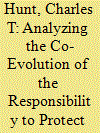

|
|
|
|
|
| Summary/Abstract |
This article analyses the Responsibility to Protect (R2P) in conjunction with the Protection of Civilians (POC) in peace operations. It examines where and how the two concepts have challenged, altered, led to reinterpretations and had feedback effects on each other. Drawing on methods from discourse analysis, the article examines their: gradual institutionalization at the United Nations (UN); deployment in the practices of the Security Council; and, influence over the actions of operations in the field. The analysis shows that the R2P has co-evolved with POC and particularly the implementation of POC through UN peace operations. The article illustrates that the emergence of the R2P and the trends in POC in peace operations have cross-fertilised in discourse and practice at the UN regarding the prevention and response to egregious of human rights abuses. It argues that this has influenced their respective trajectories with ramifications for understanding the normative trajectory and status of the R2P as it enters its third decade in popular lexicon. In particular, it posits that understanding the current and future status of the R2P will be enhanced by insights into how the R2P has shaped, but also been shaped by, other contiguous normative agendas, thematic areas and practices.
|
|
|
|
|
|
|
|
|
|
|
|
|
|
|
|
| 3 |
ID:
162455
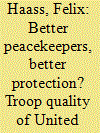

|
|
|
|
|
| Summary/Abstract |
Why do similarly sized peacekeeping missions vary in their effectiveness to protect civilians in conflicts? We argue that peace operations with a large share of troops from countries with high-quality militaries are better able to deter violence from state and non-state actors and create buffer zones within conflict areas, can better reach remote locations, and have superior capabilities – including diplomatic pressure by troop contributing countries – to monitor the implementation of peace agreements. These operational advantages enable them to better protect civilians. Combining data from military expenditures of troop contributing countries together with monthly data on the composition of peace operations, we create a proxy indicator for the average troop quality of UN PKOs. Statistical evidence from an extended sample of conflicts in Africa and Asia between 1991 and 2010 supports our argument.
|
|
|
|
|
|
|
|
|
|
|
|
|
|
|
|
| 4 |
ID:
116357
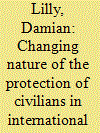

|
|
|
|
|
| Publication |
2012.
|
| Summary/Abstract |
The protection of civilians is a priority in most international peace operations today. There are important differences in the concept, however, in the operations undertaken for example by the UN, NATO, EU and the AU. In particular, a distinction needs to be made between the protection of civilians in 'peacekeeping' as compared to 'peace enforcement' operations. While in the former a 'proactive' approach to protecting civilians is usually adopted, in the latter a 'reactive' approach is normally required. These theoretical differences present important implications for those decision-makers mandating the operations as well as those involved in planning and implementing them in the field.
|
|
|
|
|
|
|
|
|
|
|
|
|
|
|
|
| 5 |
ID:
152386
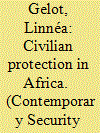

|
|
|
|
|
| Summary/Abstract |
This article explores how the protection of civilians is being militarized by African policymakers and diplomats. I draw on practice approaches to analyze what social groups are doing when they claim to “protect civilians.” I show how innovative protection mechanisms can be seen as a function of officials and diplomats coping with the changing circumstances of increasingly militarized politics in Africa. Specifically, accountability mechanisms for unintended and intended civilian harm by African security operations have originated in connection with this development. I argue that these are results of anchoring practices, which means that everyday informal interactions in one context become linked to another context. I argue that these emerging accountability mechanisms represent a new combination of practices, with the potential of changing the routine activities and mutual learning between policymakers and diplomats.
|
|
|
|
|
|
|
|
|
|
|
|
|
|
|
|
| 6 |
ID:
177846
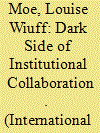

|
|
|
|
|
| Summary/Abstract |
Within the field of international peace and security, policy makers and analysts alike commonly treat collaboration and convergence among international organizations and intervention frameworks as a policy objective in itself. Indeed, from the focus on the ‘comprehensive approach’, during the 2000s, to the recent emphasis on multi-dimensional and integrated stabilization frameworks, institutional collaboration is cast as inherently positive and desirable in regard to addressing international collective matters. This article challenges such ‘collaboration bias’. It does so by exploring the empirical effects of increasing collaboration and ‘strategic partnerships’ within the context of the current (re)turn to stabilization interventions. Specifically, focusing on Mali, it unpacks how contemporary stabilization efforts intensify collaboration across counterterrorism and peacekeeping interventions in ways that undercut policy implementation within one of the most central peacekeeping priority areas, namely the Protection of Civilians (PoC). In detailing key aspects on which contemporary peacekeeping-counterterrorism entanglements compromise protection efforts, the article conveys some of the ‘dark sides’ of cooperation regimes. It moreover highlights the need to not only explore regime complexity as a systemic feature of world politics but also unpack how it operates, and to what effect, at the meso and micro levels of policy implementation and practice.
|
|
|
|
|
|
|
|
|
|
|
|
|
|
|
|
| 7 |
ID:
174046
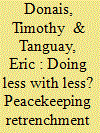

|
|
|
|
|
| Summary/Abstract |
The United Nations (UN) Secretary-General António Guterres’s Action for Peacekeeping initiative represents the latest in a series of efforts to make the UN’s peace and security architecture “fit for the future.” The Action for Peacekeeping initiative, however, has exposed two seemingly contradictory tendencies at work in contemporary peacekeeping. On the one hand, peacekeeping operations are increasingly expected to be lean, efficient, and performance-focused. On the other, expansive protection of civilians (PoC) mandates, which entail everything from predicting and pre-empting attacks against civilians to reforming state-level security institutions, are becoming increasingly central to contemporary peacekeeping. In this paper, we will suggest that as currently framed, the UN’s peacekeeping reform agenda—driven at least in part by downward budgetary pressures—will inevitably increase the gap between promise and performance with regard to PoC, with serious implications for the credibility and legitimacy of UN missions among the populations they are mandated to protect.
|
|
|
|
|
|
|
|
|
|
|
|
|
|
|
|
| 8 |
ID:
120225
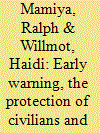

|
|
|
|
|
| Publication |
2013.
|
| Summary/Abstract |
This commentary traces the increasing importance of early warning in United Nations (UN) peacekeeping, an emphasis that has emerged in connection with the evolution of protection of civilians mandates in UN peacekeeping missions. It examines the current and emerging practice of early warning in UN peacekeeping as well as the challenges faced, drawing on case studies from the UN missions in South Sudan and the Democratic Republic of the Congo. The authors also propose a set of basic principles upon which early warning in UN peacekeeping operations might be approached in the future.
|
|
|
|
|
|
|
|
|
|
|
|
|
|
|
|
| 9 |
ID:
143564
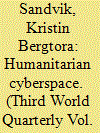

|
|
|
|
|
| Summary/Abstract |
In an effort to contribute to a more critical understanding of the role of information and communication technology (ICT) in humanitarian action, this article explores the topography of the ‘humanitarian cyberspace’ – a composite of ‘cyberspace’ and ‘humanitarian space’ – as it has emerged since the mid-1990s. The goals are to offer some observations about the conditions of the humanitarian cyberspace and to reflect on the relationship between the persistent features of humanitarian action and new developments brought on by ICT. The prism through which the role of ICT in humanitarian action is explored is that of the ‘shrinking humanitarian space’.
|
|
|
|
|
|
|
|
|
|
|
|
|
|
|
|
| 10 |
ID:
169244
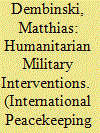

|
|
|
|
|
| Summary/Abstract |
The article offers a much-needed impulse to the debate on humanitarian military interventions, which is characterized by conceptual confusion and a lack of comparative research. Based on a comprehensive review of the literature, we identify the most important definitional controversies and discuss the conceptual pros and cons of the respective positions. We illustrate how definitional choices affect comparative research using a new dataset covering all humanitarian military interventions since the Second World War. Classic definitions based on ideal types might have normative merits, but they cannot ground an empirical research programme because they vacate the universe of cases. However, military interventions for declared humanitarian purposes are here to stay, and they should be analysed instead of defined into oblivion. Thus, the definition should reflect the practice of humanitarian military interventions, not subordinate the humanitarian purpose to violations of sovereignty and international law. The definition must not be restricted to interventions reacting to death tolls that ‘shock the conscience of mankind’; it must also consider interventions in the early stages of conflict. Moreover, military interventions should not be disregarded when the humanitarian motive is not exclusive or predominant.
|
|
|
|
|
|
|
|
|
|
|
|
|
|
|
|
| 11 |
ID:
153148
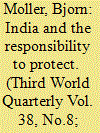

|
|
|
|
|
| Summary/Abstract |
‘Responsibility to protect’ (R2P) is an ‘emerging norm’ of international relations, which has been invoked with the intervention in Libya in 2011. Even though this intervention was demanded by several Third World countries and organisations, these have subsequently had second thoughts about the matter and have come to regard R2P as Western neo-imperialism. This article seeks to explain this apparent paradox, with a special focus on India. It also identifies possible compromises by advocating a broader approach to R2P, stressing the responsibility to prevent and to rebuild. It also draws attention to ‘R2P lite’, including the protection of civilians in armed conflicts.
|
|
|
|
|
|
|
|
|
|
|
|
|
|
|
|
| 12 |
ID:
151524


|
|
|
|
|
| Summary/Abstract |
This article analyses direct forms of the ‘protection of civilians’ (PoC) in United Nations (UN) peacekeeping, and how this links to aspirations outlined by cosmopolitan scholarship at the turn of the twentieth century. Its main contention is that cosmopolitan conceptions of peacekeeping, which advocate more active forms of civilian protection, have faced significant challenges in the UN peacekeeping system. These challenges (internal and external) are a result of the state-based nature of the UN, and its peacekeeping practice. Therefore, the UN’s flexibility to adopt ethical practices associated with PoC can only be contained within confined boundaries. The article takes as its starting point the aspirations of cosmopolitan scholarship before outlining policy development in UN peacekeeping concerning PoC. It then explores internal and external challenges faced in operationalizing PoC in UN peacekeeping practice before arguing that the UN may be at a stage where it is ‘muddling through’ in terms of PoC. The article contributes to debates about the role of peacekeeping in global politics, through seeking to understand the possible limits of cosmopolitanism within peacekeeping practice. Moreover, it offers a contemporary understanding of where the UN has developed PoC in its deployments and what challenges remain.
|
|
|
|
|
|
|
|
|
|
|
|
|
|
|
|
| 13 |
ID:
179555
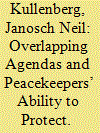

|
|
|
|
|
| Summary/Abstract |
This article scrutinizes the overlaps between three major UN policy agendas to explain how their interaction impacts the delivery of protection, particularly against conflict-related sexual violence (CRSV). Building on Pierre Bourdieu, it reconstructs the ‘field of international interventions’ and subsequently analyses the evolution of the protection mandate, highlighting the complementarities and contradictions between Children and Armed Conflict, Protection of Civilians and Women, Peace and Security. My findings suggest that while these agendas have reinforced each other during their establishment and institutionalization, the multiplication of administrative structures has also led to the compartmentalization of protection. The field’s competitive pressures, furthermore, push organizations to focus on their own mandates and subsume aspects of other agendas under them. Data from the Democratic Republic of Congo indicate that despite recognizing the need for gender-sensitive approaches, UN peacekeeping largely continues to understand protection against CRSV as part of its general protection efforts. Therefore, the militarized and gender-ignorant approach to protection prevails and specific measures to address sexual violence remain too headquarters-driven.
|
|
|
|
|
|
|
|
|
|
|
|
|
|
|
|
| 14 |
ID:
179551
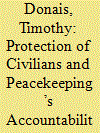

|
|
|
|
|
| Summary/Abstract |
Debates around performance and accountability are now front and centre in discussions around peacekeeping reform. Both concepts are prominent in the UN Secretary-General’s Action for Peacekeeping Initiative, while the Security Council recently stressed the need to improve ‘posture, behaviour, leadership, initiative and accountability’ within peace operations. This paper explores the politics of the accountability debate and the prospects for improved peacekeeper accountability in the context of protection of civilians (PoC) mandates, with an understanding that civilians in conflict often need protection not only from conflict parties but also – as the struggles with sexual exploitation and abuse (SEA) demonstrate – from peacekeepers themselves. While strengthened accountability mechanisms can help bridge the gap between the promise and the practice of protection, declining peacekeeping budgets and the amorphous and all-encompassing nature of PoC mandates complicate developing specific performance metrics and accountability mechanisms. Thus, while the UN has struggled to ensure misconduct accountability with regard to SEA, performance accountability represents a challenge of considerably greater magnitude. Absent serious consideration of the structural impediments involved, and the imperative of managing ambiguity, the accountability/performance debate may do little more than exacerbate tensions between those countries who staff peacekeeping missions and those who pay for them.
|
|
|
|
|
|
|
|
|
|
|
|
|
|
|
|
| 15 |
ID:
107683


|
|
|
| 16 |
ID:
174331
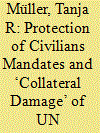

|
|
|
|
|
| Summary/Abstract |
This article contributes to refining our understanding of how a robust Protection of Civilians mandate in peacekeeping missions may have unintended and harmful consequences for key local actors involved. It focuses specifically on local mission staff employed to collect vital data on human rights abuses, taking the example of the hybrid UN-African Union (AU) peacekeeping mission in Darfur, UNAMID. It further explores how the UN system lacks a clear policy or automatically built-in mechanisms to prevent potential harm to those on whose local knowledge it relies. While predominately based on interview data with a small number of former UNAMID frontline human rights data-collectors from Darfur, the dynamics unveiled speak to more general issues when interrogating protection of civilians as the central pillar of UN peacekeeping missions, also beyond scenarios where the government of a host-state is hostile to the mission. The article concludes that the protection of local staff should feature prominently in any mission’s approach, including an active commitment to withdraw staff from their positions if their security is threatened or compromised.
|
|
|
|
|
|
|
|
|
|
|
|
|
|
|
|
| 17 |
ID:
185511
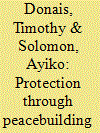

|
|
|
|
|
| Summary/Abstract |
Protecting civilians has been the primary raison d’être of the UN Mission in South Sudan (UNMISS) since civil war erupted in late 2013. Since then, UN efforts to protect vulnerable civilians have focused on a handful of so-called protection of civilians (PoC) sites. While they have unquestionably saved lives, the PoC sites have also absorbed the lion’s share of mission resources, severely limiting UNMISS’ ability to protect civilians elsewhere. The signing of the still-fragile Revitalised Agreement on the Resolution of the Conflict in South Sudan (R-ARCSS) has enabled a reconsideration of the UNMISS protection mandate in light of what remains an uncertain transition. Given the systemic constraints on the UN’s ability to project force in the name of PoC, we argue that UNMISS’ most constructive and lasting contribution to both protection and peace in South Sudan will be through sustained investments in inclusive local-level peacebuilding. Re-orienting the PoC mandate along these lines offers an opportunity to at least partially counteract the decidedly exclusive nature of the country’s current peace process, and to support bottom-up conflict resolution processes that could eventually interact in constructive ways with top-down dynamics.
|
|
|
|
|
|
|
|
|
|
|
|
|
|
|
|
| 18 |
ID:
177757
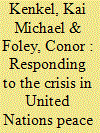

|
|
|
|
|
| Summary/Abstract |
This special forum discusses the future trajectory of UN peace operations at a time many stakeholders and analysts consider to be one of crisis, contestation, or at the very least transition. The UN is facing difficulties in responding effectively to many of the world’s worst recent conflicts, even where it has (or until recently had) operations. Even before COVID-19, the blue helmets were facing a period of serious retrenchment and budgetary constraints. Mission mandates have experienced a transformation, from the recent “robust turn” to the incorporation of stabilization mandates grounded in counterinsurgency/counterterrorism doctrine. The crossroads of economic downturn, geopolitical realignment and continuous adaptation of peacekeeping practice provides the backdrop of the contributions to the special forum that follows. The analyses presented here not only accompany the ongoing evolution of the nexus of issues that constitute peacekeeping studies but also reflect the breadth and depth of the extensive attendant academic literature.
|
|
|
|
|
|
|
|
|
|
|
|
|
|
|
|
| 19 |
ID:
089527


|
|
|
|
|
| Publication |
2009.
|
| Summary/Abstract |
This article discusses the international response to the conflict in Darfur from 2003 onwards in order to explore some of the key challenges related to implementing the responsibility to protect (R2P). First, we show that the debates on R2P in connection to Darfur translated into little more substantive action than the pragmatic decision to deploy peace operations with mandates that included civilian protection, as suggested by the African Union (AU) Mission in Sudan (AMIS), and later by the hybrid UN-AU Mission in Darfur (UNAMID). Second, we argue that the international response to Darfur illustrates three major challenges to R2P implementation. These are: political limitations inherent in the R2P framework; moral dilemmas emerging from military action; and tactical challenges, as exemplified by the struggles faced by the AU and the UN in Darfur. We conclude that the international failure to offer meaningful protection in Darfur highlights the need for continued caution and critical analysis of the ways in which R2P is conceptualized and implemented
|
|
|
|
|
|
|
|
|
|
|
|
|
|
|
|
| 20 |
ID:
192956
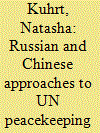

|
|
|
|
|
| Summary/Abstract |
The Sino-Russian strategic partnership, among its many facets, includes broad alignment in the United Nations Security Council (UNSC) on issues of intervention, and their similar (if not identical) stances on the controversial Responsibility to Protect (R2P) doctrine in regard to Darfur, Libya, or Syria are well known—but the Libyan R2P-inspired enforcement action (intervention absent the consent of the host state) is relatively rare. Less work has been carried out on Russian and Chinese discourse on UN peacekeeping, viz consent-based operations. We fill a gap by examining and comparing their discourse on UN peacekeeping in UN Security Council meetings, demonstrating that their converging views have begun to seep into the previously 'safe space' of peacekeeping. The controversy surrounding the 'protection of civilians' encapsulated in the Libyan resolution 1973, which was used for regime change, caused concern for Russia and China. New directions in UN peacekeeping—in particular, stabilization missions—which emphasize the protection of civilians, are testing UN peacekeeping doctrine. A comparison of Chinese and Russian voting patterns in the UNSC reveals a fairly similar line taken on voting to extend peacekeeping mandates, yet upon examining the discourse in UNSC meetings regarding three UN stabilization missions between 2011 and 2022, as well as more generic meetings on peacekeeping, subtle differences emerge, which reflect differences in Russian and Chinese narrated global identities and status concerns. These differences show that alignment is based more on converging interests than converging values.
|
|
|
|
|
|
|
|
|
|
|
|
|
|
|
|
|
|
|
|
|